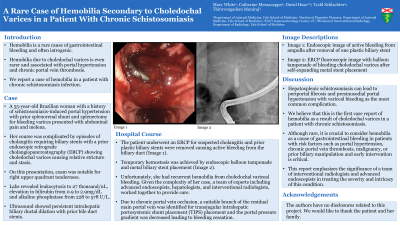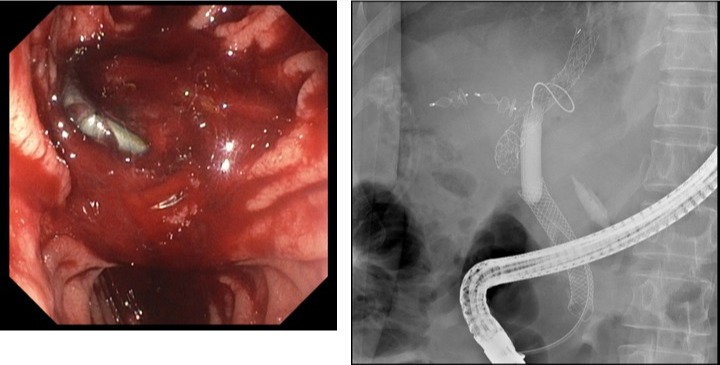Tuesday Poster Session
Category: Interventional Endoscopy
P3736 - A Rare Case of Hemobilia Secondary to Choledochal Varices in a Patient With Chronic Schistosomiasis
Tuesday, October 24, 2023
10:30 AM - 4:00 PM PT
Location: Exhibit Hall

Has Audio

Mary White, MD
Yale New Haven Hospital
New Haven, CT
Presenting Author(s)
Mary White, MD1, Catherine Mezzacappa, MD, MPH2, David J.. Hass, MD, FACG3, Todd Schlachter, MD2, Thiruvengadam Muniraj, MD, FACG2
1Yale New Haven Hospital, New Haven, CT; 2Yale University School of Medicine, New Haven, CT; 3Yale University School of Medicine/PACT Gastroenterology Center, Hamden, CT
Introduction: Hemobilia is a rare cause of gastrointestinal bleeding and often iatrogenic. Hemobilia due to choledochal varices is even rarer and associated with portal hypertension and chronic portal vein thrombosis. We report a case of hemobilia in a patient with chronic schistosomiasis infection.
Case Description/Methods: A 55-year-old Brazilian woman with a history of schistosomiasis-induced portal hypertension with prior splenorenal shunt and splenectomy for bleeding varices presented with abdominal pain and melena. Her course was complicated by episodes of cholangitis requiring biliary stents with a prior endoscopic retrograde cholangiopancreatography (ERCP) showing choledochal varices causing relative stricture and stasis. On this presentation, exam was notable for right upper quadrant tenderness. Labs revealed leukocytosis to 27 thousand/uL, elevation in bilirubin from 0.9 to 2.9mg/dL and alkaline phosphatase from 228 to 578 U/L. Ultrasound showed persistent intrahepatic biliary ductal dilation with prior bile duct stents. The patient underwent an ERCP for suspected cholangitis and prior plastic biliary stents were removed causing active bleeding from the biliary duct (Image 1). Temporary hemostasis was achieved by endoscopic balloon tamponade and metal biliary stent placement (Image 2); unfortunately, she had recurrent hemobilia from choledochal variceal bleeding. Given the complexity of her case, a team of experts including advanced endoscopists, hepatologists, and interventional radiologists, worked together to provide care. Due to chronic portal vein occlusion, a suitable branch of the residual main portal vein was identified for transjugular intrahepatic portosystemic shunt placement (TIPS) placement and the portal pressure gradient was decreased leading to bleeding cessation.
Discussion: Hepatosplenic schistosomiasis can lead to periportal fibrosis and presinusodial portal hypertension with variceal bleeding as the most common complication. We believe that this is the first case report of hemobilia as a result of choledochal varices in a patient with chronic schistosomiasis. Although rare, it is crucial to consider hemobilia as a cause of gastrointestinal bleeding in patients with risk factors such as portal hypertension, chronic portal vein thrombosis, malignancy, or prior biliary manipulation and early intervention is critical. This report emphasizes the significance of a team of interventional radiologists and advanced endoscopists in treating the severity and intricacy of this condition.

Disclosures:
Mary White, MD1, Catherine Mezzacappa, MD, MPH2, David J.. Hass, MD, FACG3, Todd Schlachter, MD2, Thiruvengadam Muniraj, MD, FACG2. P3736 - A Rare Case of Hemobilia Secondary to Choledochal Varices in a Patient With Chronic Schistosomiasis, ACG 2023 Annual Scientific Meeting Abstracts. Vancouver, BC, Canada: American College of Gastroenterology.
1Yale New Haven Hospital, New Haven, CT; 2Yale University School of Medicine, New Haven, CT; 3Yale University School of Medicine/PACT Gastroenterology Center, Hamden, CT
Introduction: Hemobilia is a rare cause of gastrointestinal bleeding and often iatrogenic. Hemobilia due to choledochal varices is even rarer and associated with portal hypertension and chronic portal vein thrombosis. We report a case of hemobilia in a patient with chronic schistosomiasis infection.
Case Description/Methods: A 55-year-old Brazilian woman with a history of schistosomiasis-induced portal hypertension with prior splenorenal shunt and splenectomy for bleeding varices presented with abdominal pain and melena. Her course was complicated by episodes of cholangitis requiring biliary stents with a prior endoscopic retrograde cholangiopancreatography (ERCP) showing choledochal varices causing relative stricture and stasis. On this presentation, exam was notable for right upper quadrant tenderness. Labs revealed leukocytosis to 27 thousand/uL, elevation in bilirubin from 0.9 to 2.9mg/dL and alkaline phosphatase from 228 to 578 U/L. Ultrasound showed persistent intrahepatic biliary ductal dilation with prior bile duct stents. The patient underwent an ERCP for suspected cholangitis and prior plastic biliary stents were removed causing active bleeding from the biliary duct (Image 1). Temporary hemostasis was achieved by endoscopic balloon tamponade and metal biliary stent placement (Image 2); unfortunately, she had recurrent hemobilia from choledochal variceal bleeding. Given the complexity of her case, a team of experts including advanced endoscopists, hepatologists, and interventional radiologists, worked together to provide care. Due to chronic portal vein occlusion, a suitable branch of the residual main portal vein was identified for transjugular intrahepatic portosystemic shunt placement (TIPS) placement and the portal pressure gradient was decreased leading to bleeding cessation.
Discussion: Hepatosplenic schistosomiasis can lead to periportal fibrosis and presinusodial portal hypertension with variceal bleeding as the most common complication. We believe that this is the first case report of hemobilia as a result of choledochal varices in a patient with chronic schistosomiasis. Although rare, it is crucial to consider hemobilia as a cause of gastrointestinal bleeding in patients with risk factors such as portal hypertension, chronic portal vein thrombosis, malignancy, or prior biliary manipulation and early intervention is critical. This report emphasizes the significance of a team of interventional radiologists and advanced endoscopists in treating the severity and intricacy of this condition.

Figure: Images from left to right:
1. Endoscopic image of active bleeding from ampulla after removal of one plastic biliary stent
2. ERCP fluoroscopic image with balloon tamponade of bleeding choledochal varices after self-expanding metal stent placement
1. Endoscopic image of active bleeding from ampulla after removal of one plastic biliary stent
2. ERCP fluoroscopic image with balloon tamponade of bleeding choledochal varices after self-expanding metal stent placement
Disclosures:
Mary White indicated no relevant financial relationships.
Catherine Mezzacappa indicated no relevant financial relationships.
David Hass indicated no relevant financial relationships.
Todd Schlachter: Boston Scientific – Consultant.
Thiruvengadam Muniraj indicated no relevant financial relationships.
Mary White, MD1, Catherine Mezzacappa, MD, MPH2, David J.. Hass, MD, FACG3, Todd Schlachter, MD2, Thiruvengadam Muniraj, MD, FACG2. P3736 - A Rare Case of Hemobilia Secondary to Choledochal Varices in a Patient With Chronic Schistosomiasis, ACG 2023 Annual Scientific Meeting Abstracts. Vancouver, BC, Canada: American College of Gastroenterology.
